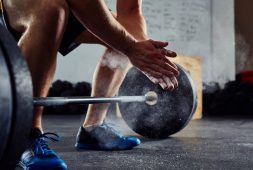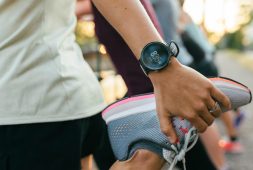
Many people are under the impression that they need to lift heavy weights in order to get stronger and more toned glutes, and squats are actually one of the best types of exercises to help do exactly that. And while most people would like to know how many squats they should do in a day to make their butts bigger and nicer, there isn’t actually some magical number to turn to.
According to NASM-certified trainer at the BodyRoc FitLab in Connecticut, Nicole Blades, “Strength training boasts plenty of benefits for your overall health and wellness, but one thing exercise cannot do is grow you a ‘bigger’ booty. What daily or weekly squats will do is strengthen those big muscles in your lower body – primarily the quadriceps, hamstrings, glutes, and hips.”
Another certified trainer at obé Fitness, Walter Kemp, explains that there’s no perfect number of squats since people simply have different body types. Kemp also says, “We are all built differently and have different needs as far as muscle development.”
But if you want to have a nicer, rounder backside, the best way to do that is to follow a number of different exercises that will target all the muscles that are in your glutes. It’s just as important to work out all the muscles in order get that nicer, rounder booty you’ve been wanting.
Here are some tips about your glutes that will help you get the most out of your squat to get your butt into tip top shape!
What Muscles Are In Your Glutes?
There are three muscles in your glutes, the gluteus medius, gluteus minimus, and gluteus maximus. The largest one is the gluteus maximus, which also gets the brunt of the movement, especially when doing a bunch of butt exercises, deadlifts, running and squats. But the other muscles need attention too.
As for the gluteus medius and minimus, they are the ones that take care of abduction, which is the motion of moving your legs away from the midline, as well as being responsible for hip stability and hip rotation. Although these are considered minor glute muscles, when they are weak, they can cause lower-back and knee pain later on.
A certified personal trainer and instructor for online fitness app on-demand workout classes Plankk Studio, Zoe Rodriguez explains, “I do a lot of resistance band work to engage the smaller glute muscles. Exercise like hip thrusts, glute bridges, and clam, can round out the top of your butt for that fuller look.” She also explains that these exercises can be used to wake up the muscles before doing squats.
How Often Should You Do Squats Each Week?
Rodriguez also shares that you shouldn’t be doing squats every single day. She explains that you should give your body at least one day of recovery when trying to make your bottom fuller. She shares, “I generally recommend doing squats two to three times a week with 36 to 48 hours of rest for that muscle group. When you work out you create micro tears in your muscle tissue, and they need time to rebuild after a workout.”
But aside from building up your glutes, she also explains that you should also focus on building stronger hip flexors as well. Rodriguez explains that it’s important to focus on those opposing muscles because they are ‘important for hip opening and preventing muscle imbalances.’
“Doing frogger stretches, banded abductions, and lunges can help target the hip flexors and make them stronger,” she adds. She also shares that the ideal amount of squats in a workout is at least 10 to 15 reps for at least three to four rounds. Rodriguez goes on to say, “You want to focus on volume instead of adding load. This gets you into the hypertrophic range to encourage muscle growth.”
So What Is the Proper Squat Form?

The most important thing when it comes to doing a proper squat with the perfect form is making sure that you engage your core. According to trainer Kemp, “Keeping your core engages helps easily prevent avoidable injuries, like lower-back strain. Maintaining a straight back and keeping your gaze forward can help with this.”
The fitness experts also share some other tips on keeping good form when doing squats:
For Your Hips
If you want your squat to be strong, then you need to make sure that your hip hinge is solid as well, Rodriguez conveys. This will also make sure that you lead with your hips and not your knees. One of the most common mistakes that people make when doing squats is pushing their hips forward while tilting their pelvis back.
Instructor Blades says, “It’s like tucking your tailbone under you instead of pushing it back as you descend into the squat.” Again, Rodriguez explains that to correct this simply sit back on your heels and make sure that your knees are pointed out toward your pinky toes.
For Your Feet
The fitness experts also suggest that when it comes to your feet, make sure that you stand with them hip-distance apart, keeping your hands at your sides or in front of you. Keep your feet firmly planted on the floor as you push your butt back into a squat while sitting back into your heels. This will allow you to activate your quads and tighten your glutes at the same time. When you tighten your glutes, it helps stabilize your hips, which will also allow more momentum as you move up and down in one fluid motion.
For Your Thighs
Your thighs offer support when it comes to doing the proper squat because they stabilize your hip flexors and glutes. As you do your squats, notice your thighs as you lower your hips up and down, making sure they are parallel to the floor, which then forms a right angle. Kemp claims, “Make sure your knees are in line with your ankles and that you can see your toes. Your calves should also be at a 90-degree angle – move as though you are sitting down on a lower chair.”
Meanwhile, trainer Blades prefers to imagine that she’s inside a tight box while pressing her knees against the sides. She explains that this should help strengthen your foundation, allowing you to squat ever lower, as well as develop and enhance your range of motion.
For Your Chest
The trainers also explain that you should make sure your chest is lifted during the entire movement. It’s important not to slouch, because this will put extra pressure on your lower body, which can cause lower back pain. Rather, as you lean forward, try to do it at a 45-degree angle. Kemp shares, “If you are bending the spine you aren’t working the abdominals. Keep the spine straight and the abs engaged. It might help to look forward rather than down at the floor.”
How Low Should You Squat?
Again, the answer to this question varies from person to person. The experts say that you can go as low as possible for as long as you have good form. If your form begins to break down after a certain height, then don’t attempt to go down further. The ideal is to hit a 90-degree angle or even lower if possible, but only if you can maintain the proper form. As explained by Rodriguez, “Once you’re at the bottom, drive through with your heels. I sometimes like to lift the front toes out a little because it helps me focus on pushing my heels.”
What Are Other Advanced Squat Moves?

Although squats alone are already pretty challenging, there are ways that you can still upgrade them to be even more intense. Just remember that it’s important to not over do it. Blades recommends adding some plyometrics like squat jacks, squat jumps or box jumps. You can also try small changes like widening your toes out for a sumo squat will work your inner thighs. You can work on a few different ranges of motion to add a bit of a challenge to your squat, just keep in mind that you need to always have the proper form.
For Rodriguez, she likes to add some pulses in while at the bottom of her squat before standing back up to help intensify the motion. Meanwhile, Blades adds weights like dumbbells to do squat thrusters, which entails pressing the weights up above your head as you move into your standing position. You can use a variety of resistance like dumbbells, kettlebells, or resistance bands as well. In the end, not only will your booty be more rounded and defined, but your whole body will benefit from being consistent with your squat workouts.



